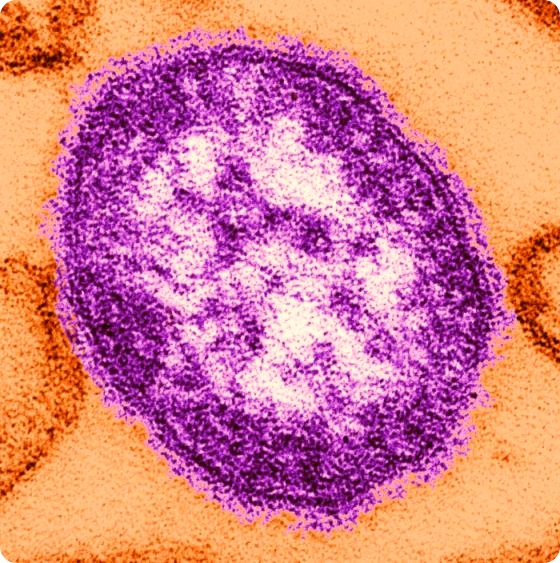Measles is a highly infectious viral illness. It is common among children but may affect people of all age groups. Measles, like most other viral ailments, may have a benign course with few complications other than fever and a rash. However, in special vulnerable populations like malnourished children and those with a diminished immunity this can lead to serious complications including death.
Measles is rare these days due to effectiveness of the Measles vaccine given in the combined shot of MMR vaccine (Measles, Mumps and Rubella).

| This thin-section transmission electron micrograph (TEM) revealed the ultrastructural appearance of a single virus particle, or “virion”, of measles virus. The measles virus is a paramyxovirus, of the genus Morbillivirus. It is 100-200 nm in diameter, with a core of single-stranded RNA, and is closely related to the rinderpest and canine distemper viruses. Two membrane envelope proteins are important in pathogenesis. They are the F (fusion) protein, which is responsible for fusion of virus and host cell membranes, viral penetration, and hemolysis, and the H (hemagglutinin) protein, which is responsible for adsorption of virus to cells. |
Transmission of measles
Measles can occur at all ages but children between the ages of 1 and 4 are most at risk. The virus is spread via millions of tiny droplets that are sneezed or coughed out by an infected person. Persons around who breathe in the droplets with the virus can catch the infection. Infection can also be spread when objects contaminated with the droplets are touched and the hands are brought near the nose of mouth.
Symptoms of measles
The initial symptoms of measles are much like a common cold of flu. There is high fever, red and runny eyes and nose and a characteristic rash. There are greyish white spots in the mouth and throat.
After a few days a red-brown spotty rash will appear all over the body. This starts behind the ears commonly and spreads around the head and neck before spreading to the legs and the whole body.
Risks associated with measles
Measles is a notifiable disease. This means that any doctor who diagnoses the infection must inform the local health authority in order to identify the source of the infection to stop it from spreading further.
Complications of measles include pneumonia, meningitis and even death.
Pregnant mothers who contract measles may be at a serious risk of transmitting the infection to the child. Several congenital abnormalities may occur in the unborn baby is exposed to the infection before birth. Measles in pregnancy can cause miscarriage, premature labour or a baby with low birth weight.
Treatment of measles
There is no specific treatment for measles since it is a viral illness that resolves on its own. An infected person, however, needs supportive care like use of fever reducing medications (Paracetamol/Acetaminophen) and plenty of fluids.
Prevention of measles
The best way to prevent measles is to vaccinate the child. Commonly the first dose of measles, mumps and rubella (MMR) vaccine is given when the child is around 13 months old. A booster is given before the child starts school.
Measles vaccine cannot be given to pregnant mothers but all women intending to become pregnant must be vaccinated against the virus.
Measles statistics
Measles is still the leading cause of vaccine-preventable childhood mortality in the world. In the UK, vaccine uptake rates for measles, mumps and rubella (MMR) in children aged two reached 90% in the first quarter of 2011. The number of people with confirmed measles in England and Wales between January and August 2011 was 836. In the USA, measles has been virtually eradicated since 2002.
Further Reading